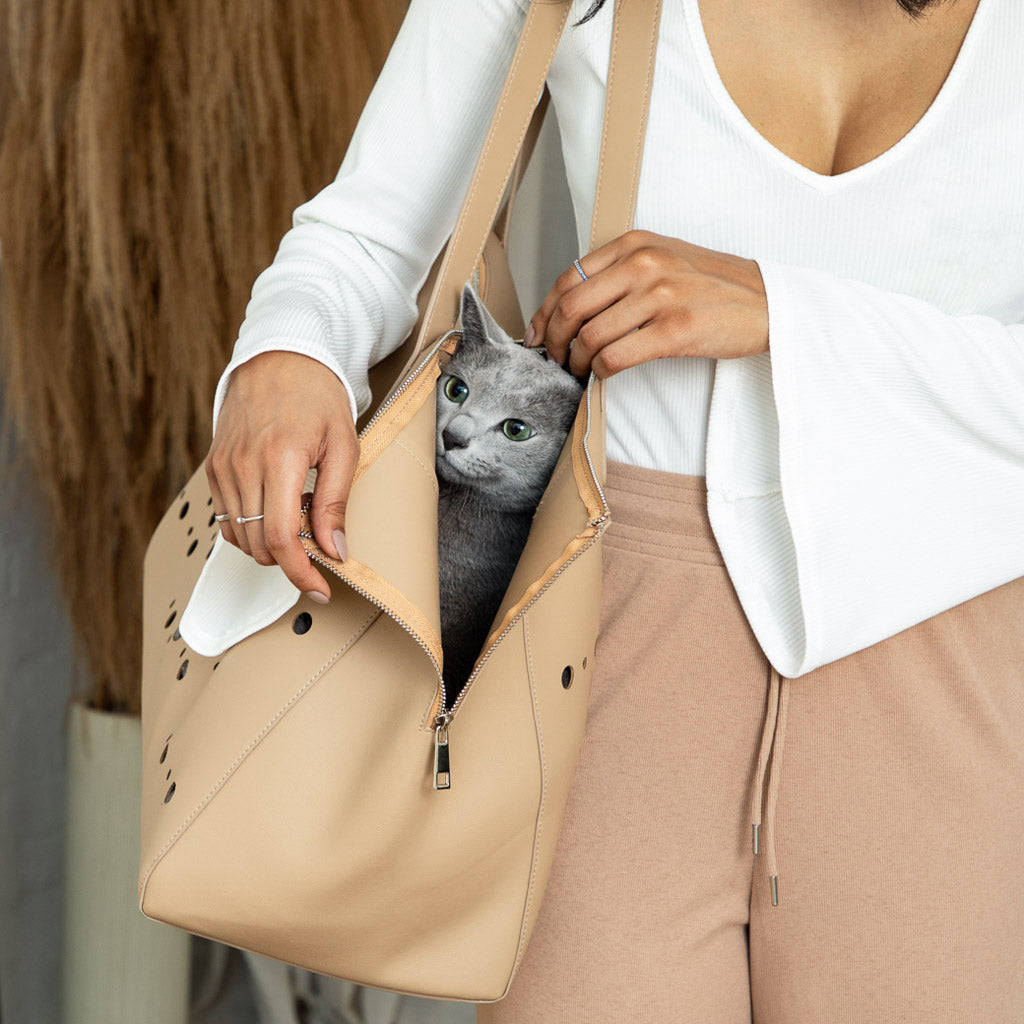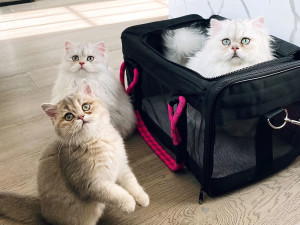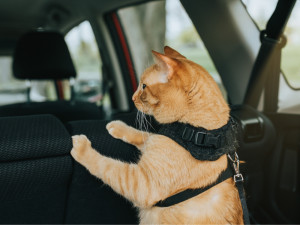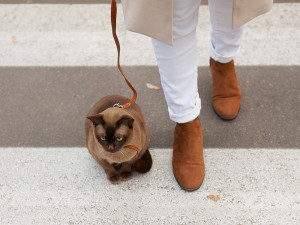How to Get a Cat in a Carrier
Here’s how you can train your stubborn cat to do one of their least-favorite things.
At the top of the list of things cat parents hate most: getting their kitty into their carrier. That’s partly because many people attempt this 20 minutes before they need to leave for a visit to the vet or as they are frantically packing for the holidays. Getting a cat into a carrier in a manner that is not upsetting is not something that happens quickly — or by magic.
It’s best to train our cats to travel in cat carriers rather than to force them in on short notice. This requires advance planning and a long-term effort. It’s easier to start carrier-training cats when they are young, but cats of any age will benefit from carrier training that has been done with positive reinforcement, patience, and a complete avoidance of rushing the process. Teaching your cat to enter a carrier in a way that makes it a positive and safe space is easier if you remember that, for the cat, this is a specific skill that can be achieved through training.
Save on the litter with color-changing tech that helps you better care for your cat.
What is carrier training for cats?
Carrier training for cats means teaching cats to enter and be comfortable in their carrier. So many people make their cats enter their carrier when they need to take them somewhere, which can be traumatizing for cats — and, to be honest, hazardous for people. Carrier training is the way to make life easier for cats and for people because a cat who is trained to enter a carrier does not need to be forced into one.
Is carrier training essential for cats?
Carrier training is essential for cats because of what it allows us to do and how it can improve our cat’s life and keep them safe. The use of carriers is very practical so we can transport our kitties to the vet or take them with us easily when we travel or when we move. It is safer for a cat to travel in a carrier when in the car than to be loose in the vehicle.
How much do you spend on your pet per year?
A carrier offers cats some protection in case of an accident or sudden stop, and it makes it less likely that they will escape when we start our journey or when we arrive at our destination. Sadly, there is always the risk of natural disasters or other emergencies and being able to put our cat in a carrier in these situations is a way to keep them safe and get them to a better location with less stress for everyone.
How long can a cat stay in the carrier?
Generally, cats can stay in a carrier for six hours if they are trained to be in a carrier and comfortable in it. The expectation to have a cat in a carrier for that long is only reasonable after they have learned to be comfortable in one and have been in it many times for much shorter periods of time.
Part of the process of training a cat to be in a carrier is giving them opportunities to be in it for very short times at the beginning (think seconds, not minutes or hours) and gradually increasing the length of time they spend in the carrier. The length of time your cat can be in a carrier may be shorter or longer, depending on their health and their willingness to eat or drink while confined. Check with a veterinarian to make sure you are doing what’s best for your cat.
How to secure a cat carrier in the car
The purpose of the cat carrier is to keep your most precious cargo — your cat — safe. Just having them in the carrier is safer than having them loose in the car, but where to put the cat carrier in the car and how to secure it are considerations that add to safety.
The best places for the cat carrier are in the back seat or on the floor behind the front seats. It’s important to consider how to secure the cat carrier in the car. On the back seat, it can be seat belted in, and if it’s on the floor, you can secure it by moving the front seat back to wedge it in. Avoid having it in the front seat where it can be hit by an airbag or be launched through the windshield.
Step-by-step: How to train your cat to enter the carrier
Training cats to accept and even like a cat carrier requires positive reinforcement, lots of treats, and many short sessions (just a minute or two each time!) over multiple weeks. Always tailor the training to what the cat can do in that moment, not what you wish the cat would do in that moment.
Never force or coerce the cat — keep the training environment happy, positive, and fun, even if that means progressing more slowly than anticipated. That will make training go faster in the long run, limit any setbacks that will hamper the process, and make it a better experience for both you and your cat. The goal is to create a lifetime carrier-lover of your cat, not to insist your cat get into the carrier right away.
1. Bring the cat carrier into a space in your home where your cat spends time.
Don’t fall into the trap of keeping the cat carrier in a closet or basement and only bringing it out right before vet visits. That builds bad associations rather than good ones. If kept in storage, the carrier will have an unfamiliar smell, which makes it harder for your cat to like it or want to enter it.
2. Make the cat carrier appealing to your cat.
Carrier training cats is easier if what we want (for them to get in the carrier) matches up with what they want (to get into the carrier). To make that more likely, make the carrier a place where they would feel comfortable and happy.
Put cozy blankets inside. Spray the inside with Feliway, which lowers anxiety and stress in cats. Put treats right outside the carrier and also inside near the entrance. Teach your cat to associate the inside of the carrier with treats and with favorite toys they can snuggle.
3. Have your cat enter the carrier willingly — never with force or pressure.
The best way to get a cat in the carrier is for them to go in on their own. Focus on getting your cat to enter the carrier willingly. Forcing them or coercing them is counterproductive because that teaches them to be afraid of the carrier and perhaps associate negative feelings about it with you. There is a better way.
Toss treats and toys farther into the carrier after your cat is happily eating treats near the entrance. It’s much better to have your cat cheerfully enter the carrier partway to get treats than to tentatively and nervously go in all the way to reach treats near the back.
4. Increase the time your cat spends in the carrier.
Get your cat used to being in the carrier for longer periods of time. Once your cat will go in willingly, start giving treats after they enter to add to the time they spend inside. Gradually extend the length of time your cat is happily in the carrier over multiple training sessions.
5. Teach your cat to be comfortable in the carrier with the door closed.
Start by moving the door. Give your cat treats after moving the door in one session, then after closing the door, but only leave it closed for a second or less in later sessions. During subsequent sessions, gradually extend the time your cat is in there with the door shut and always offer treats.
6. Accustom your cat to traveling in the carrier over multiple sessions.
Lift the carrier, give your cat treats, and then put the carrier down. Take the carrier to the car and give your cat treats again, but don’t start the car. Then start the car, feed them treats, and turn the car off. Finally, begin to drive and have someone else in the car continue to give treats to the cat, so you can focus on the road. The main message about how to get a cat used to the carrier is that it takes practice over time.
FAQs (People also ask):
What if my cat refuses to enter the carrier?
A cat who refuses to enter a carrier is letting you know they are not comfortable yet and need more lessons and patience to get there. Continue with gentle, patient training using positive reinforcement.
My cat is fearful of the carrier. What should I do?
If your cat is afraid of the carrier, consider getting a different style of carrier and starting over with your training using a new carrier with which your cat has no bad associations.
Should I only associate the carrier with vet visits?
Associate the carrier with positive experiences as much as possible by using it to take your cat to happy places rather than just using it for vet visits.














